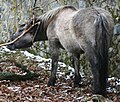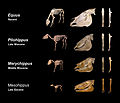Portal:Horses
The Horses PortalThe horse (Equus ferus caballus) is a domesticated, one-toed, hoofed mammal. It belongs to the taxonomic family Equidae and is one of two extant subspecies of Equus ferus. The horse has evolved over the past 45 to 55 million years from a small multi-toed creature, close to Eohippus, into the large, single-toed animal of today. Humans began domesticating horses around 4000 BCE, and their domestication is believed to have been widespread by 3000 BCE. Horses in the subspecies caballus are domesticated, although some domesticated populations live in the wild as feral horses. These feral populations are not true wild horses, which are horses that never have been domesticated and historically linked to the megafauna category of species. There is an extensive, specialized vocabulary used to describe equine-related concepts, covering everything from anatomy to life stages, size, colors, markings, breeds, locomotion, and behavior. Horses are adapted to run, allowing them to quickly escape predators, and possess a good sense of balance and a strong fight-or-flight response. Related to this need to flee from predators in the wild is an unusual trait: horses are able to sleep both standing up and lying down, with younger horses tending to sleep significantly more than adults. Female horses, called mares, carry their young for approximately 11 months and a young horse, called a foal, can stand and run shortly following birth. Most domesticated horses begin training under a saddle or in a harness between the ages of two and four. They reach full adult development by age five, and have an average lifespan of between 25 and 30 years. Horse breeds are loosely divided into three categories based on general temperament: spirited "hot bloods" with speed and endurance; "cold bloods", such as draft horses and some ponies, suitable for slow, heavy work; and "warmbloods", developed from crosses between hot bloods and cold bloods, often focusing on creating breeds for specific riding purposes, particularly in Europe. There are more than 300 breeds of horse in the world today, developed for many different uses. (Full article...) Entries here consist of Good and Featured articles, which meet a core set of high editorial standards.
 Equestrian sports are among those contested at the Summer Olympic Games. Equine events began at the Olympics in 1900, when competitions in polo (considered by the International Olympic Committee (IOC) to be a separate sport from the other equestrian events), vaulting, four-in-hand driving, mail coach driving, mixed hacks and hunters and three types of jumping (high jump, long jump and show-jumping) were held. Most of these events were later discontinued, although equestrian events have continued through the 2016 Summer Olympics, and now include team and individual dressage, three-day eventing and show-jumping. Competitors in the modern pentathlon event also have to complete an equestrian show-jumping course, but this is not part of the equestrian events. Modern-day Olympic equestrian events are rooted in cavalry skills and classical horsemanship, and through 1948, competition was restricted to active-duty officers on military horses. Only after 1952, as mechanization of warfare reduced the number of military riders, were civilian riders allowed to compete. Equestrian is the only Olympic sport in which animals compete with humans, and is one of four sports in which the genders compete against each other, the others being some sailing divisions, mixed doubles division in tennis and the mixed doubles division of badminton. The rules for Olympic equestrian competition are set by the Fédération Équestre Internationale, the international governing body for equestrian sports. (Full article...)Selected image A shepherd in Kazakhstan, who uses a horse and dogs in his trade. Latest updates
More did you know?
Related portalsEntries here consist of Good and Featured articles, which meet a core set of high editorial standards.
The New Forest pony is one of the recognised mountain and moorland or native pony breeds of the British Isles. Height varies from around 12 to 14.2 hands (48 to 58 inches, 122 to 147 cm); ponies of all heights should be strong, workmanlike, and of a good riding type. They are valued for hardiness, strength, and sure-footedness. The breed is indigenous to the New Forest in Hampshire in southern England. DNA studies have shown ancient shared ancestry with the Celtic-type Asturcón and Pottok ponies. Many breeds have contributed to the foundation bloodstock of the New Forest pony, but today only ponies whose parents are both registered as purebred in the approved section of the stud book may be registered as purebred. The New Forest pony can be ridden by children and adults, can be driven in harness, and competes successfully against larger horses in horse show competition. (Full article...)Did you know (auto-generated)
General imagesThe following are images from various horse-related articles on Wikipedia.
TopicsHorse • Pony • Asinus • Equus (genus) • Equidae • Zebra • Glossary of equestrian terms • List of horse breeds • Evolution of the horse • Domestication of the horse • Horse care • Stable • Horse training • Equestrianism • Horse tack • Saddle • Equine nutrition • Equine anatomy • Equine conformation • Equine coat color • Equine coat color genetics • Horse markings • Equine vision • Horse hoof • Horseshoe • Horse gait • Horse behavior • Horse breeding • Breed registry • Equine infectious anemia • Horse colic • Lameness • Laminitis • Horse slaughter • Horses in warfare • Arabian horse • Thoroughbred SubcategoriesNew articlesThis list was generated from these rules. Questions and feedback are always welcome! The search is being run daily with the most recent ~14 days of results. Note: Some articles may not be relevant to this project.
Rules | Match log | Results page (for watching) | Last updated: 2024-05-31 20:31 (UTC) Note: The list display can now be customized by each user. See List display personalization for details.
WikiProjectsAssociated WikimediaThe following Wikimedia Foundation sister projects provide more on this subject:
Discover Wikipedia using portals |



























































